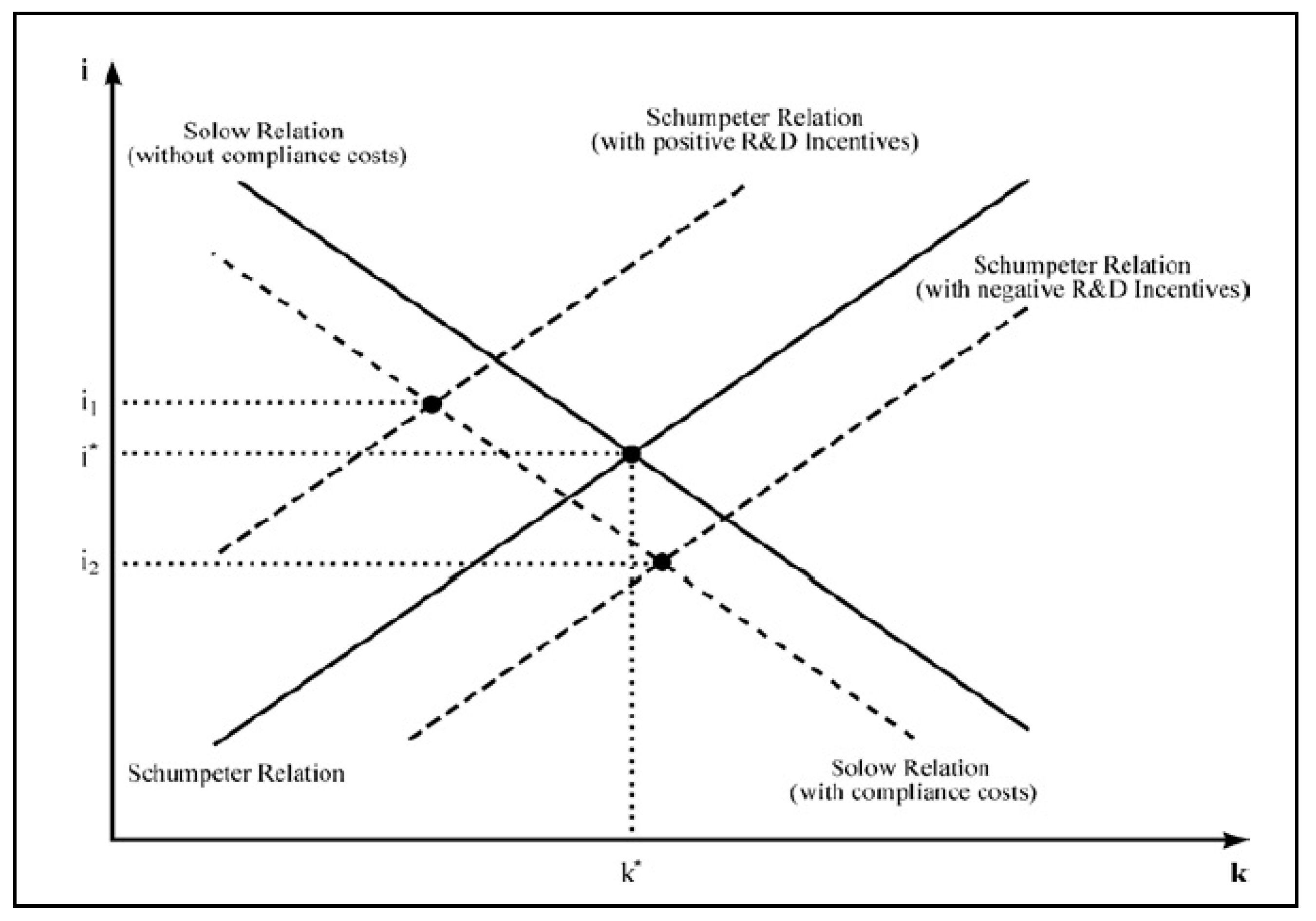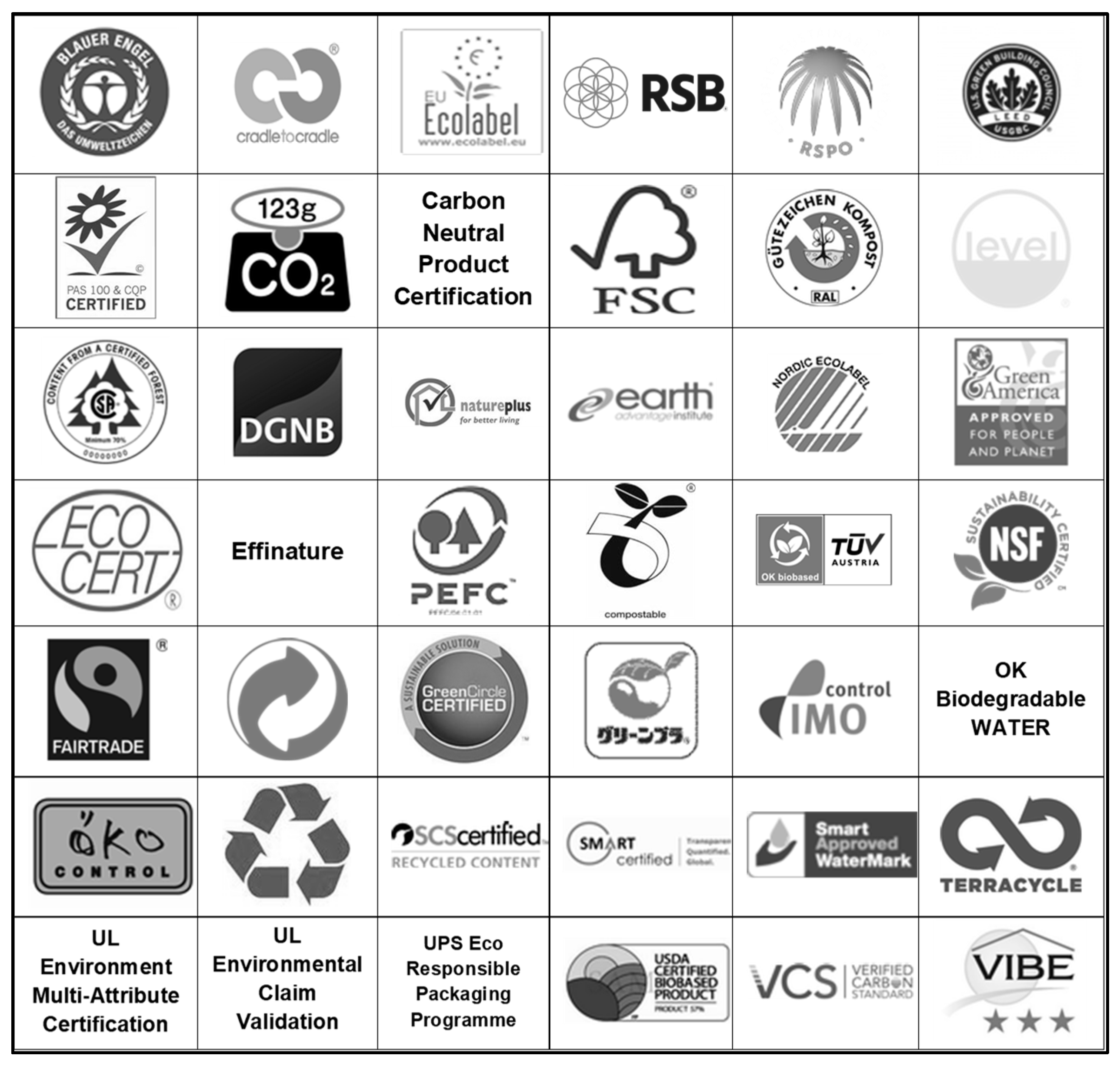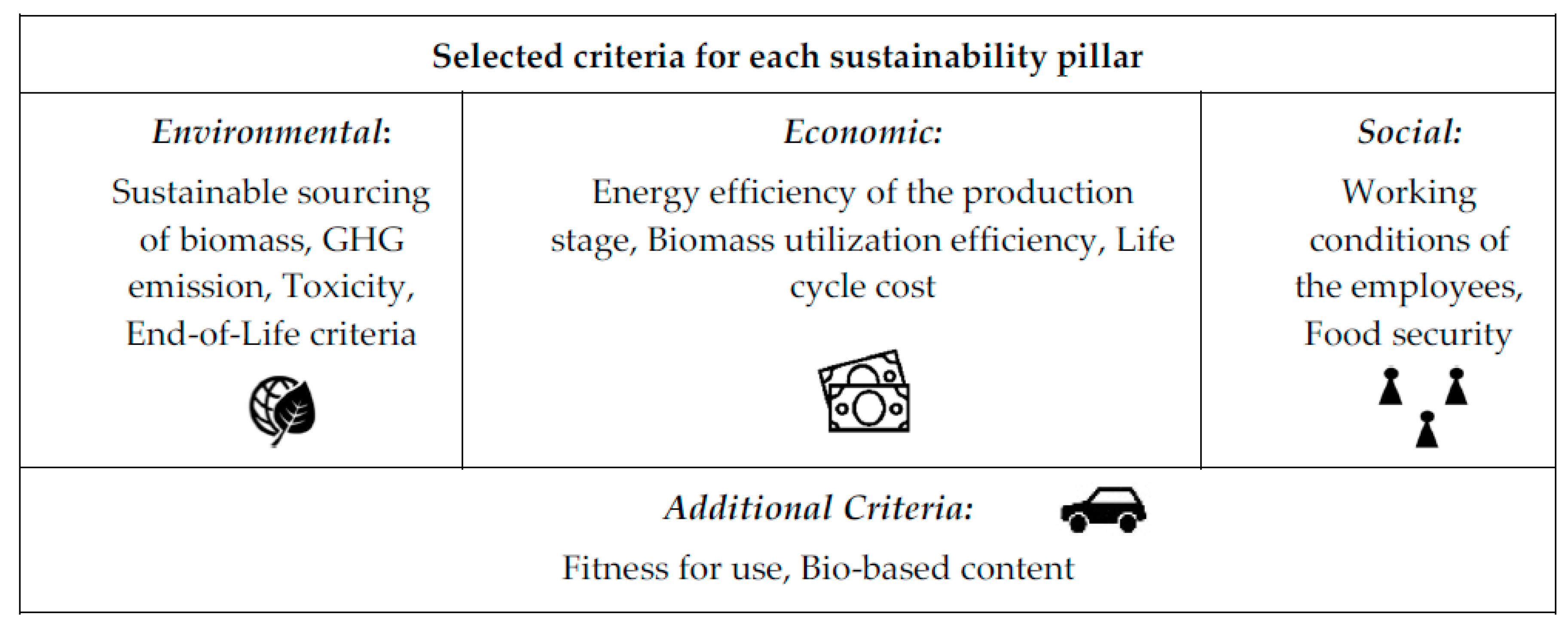Bio-Based Products in the Automotive Industry: The Need for Ecolabels, Standards, and Regulations
Abstract
1. Introduction
1.1. Rationale for this Article
1.2. Novelty of this Research
2. Materials and Methods
2.1. Core Research Elements
2.1.1. Bio-based Automotive Applications
2.1.2. Ecolabels
2.1.3. Formal Standards
2.1.4. Regulatory Framework
2.2. Research Goals and Methodologies
- (a)
- Sustainability criteria: Environmental, social and economic criteria.
- (b)
- Additional criteria: Percentage of bio-based content and fitness for use.
3. Results
3.1. Analysis of the Existing Ecolabels Landscape
3.1.1. Selected Criteria for the Environmental Pillar
Sustainable Sourcing of Biomass
- Greenhouse gas emission saving from the use of biofuels and bioliquids shall be at least 50% compared to fossil fuels (60% for biofuels produced in plants whose operation started after 1 January 2017) (see [37]).
- (Sustainable) biofuels and bioliquids shall not be made from raw material obtained from land with high biodiversity.
- (Sustainable) biofuels and bioliquids shall not be made from raw material obtained from land with high carbon stock (such as wetlands or forests).
Emissions of Greenhouse Gas (GHG)
Toxicity
End-of-Life Criteria
3.1.2. Selected Criteria for the Economic Pillar
Energy Efficiency of the Production Stage
Biomass Utilization Efficiency
Life Cycle Cost
3.1.3. Selected Criteria for the Social Pillar
3.1.4. Additional Criteria Related to Bio-based Characteristics and Performance
Bio-Based Content
Fitness for Use
3.1.5. Life Cycle Assessment
3.2. Results of the Expert Interviews and Related Research in the Automotive Industry
3.2.1. Ecolabels for Bio-Based Automotive Applications
General Considerations
Ecolabel Criteria
Solutions Suggested by Interviewees
3.2.2. Regulatory Measures to Support Bio-based Automotive Applications
3.2.3. Standards to Support Bio-based Automotive Applications
3.3. Reflective Comparison of the Automotive Industry with other Bio-based Products
4. Discussion
4.1. Fulfilment of Our Research Goals and Summary of Findings
4.2. Recommendations
4.3. Outlook
Author Contributions
Funding
Conflicts of Interest
Appendix A. Information on the Ecolabels Analyzed for This Study
References
- IfBB—Institut für Biokunststoffe und Bioverbundwerkstoffe. Hannover Messe: Niedersachsens Wissenschaftsminister Thümler Informiert Sich am Stand des IfBB; IfBB: Hannover, Germany, 2018. [Google Scholar]
- Blain, B.L. Japan Proposes Wooden Cars Made of Plant-Based Cellulose Nanofibers. 2019. Available online: https://newatlas.com/automotive/cnf-cellulose-nanofibers-wooden-car/ (accessed on 27 December 2019).
- Lanzini, P.F.; Testa, F.F. Iraldo, Factors affecting drivers’ willingness to pay for biofuels: The case of Italy. J. Clean. Prod. 2016, 112, 2684–2692. [Google Scholar] [CrossRef]
- STAR-ProBio. STAR-ProBio Deliverable D9.2, Recommendations for Standards and Criteria for Eco-Labels for Bio-Based Products. 2018. Available online: https://www.star-probio.eu (accessed on 21 October 2019).
- Wurster, S.; Ladu, L. Bio-based Products—Suggestions for Ecolabel Criteria and Standards in Line with the Sustainable Development Goals. Int. J. Stand. Res. (IJSR) 2020, 17, 417–435. [Google Scholar]
- CE Delft. Biobased Plastics in a Circular Economy Policy Suggestions for Biobased and Biobased Biodegradable Plastics. 2017. Available online: https://www.cedelft.eu/publicatie/biobased_plastics_in_a_circular_economy/2022 (accessed on 29 November 2018).
- Comité Européen de Normalisation. Bio-Based Products—Vocabulary; EN 16575:2014; CEN: Brussels, Belgium, 2014. [Google Scholar]
- International Organization for Standardization. Traditional Chinese Medicine—Labelling Requirements of Products Intended for Oral or Topical Use; ISO 21371:2018; ISO: Geneva, Switzerland, 2018. [Google Scholar]
- Organization for Economic Cooperation and Development. Eco-labels: The Industrialisation of Environmental Standards. Ecologist 1995, 25, 16–20. [Google Scholar]
- Retail Forum for Sustainability. 2011. Available online: http://ec.europa.eu/environment/industry/retail/pdf/labelling_issue%20paper_final.pdf (accessed on 29 November 2018).
- Organization for Economic Cooperation and Development. Effects of Eco-Labelling Schemes: Compilation of Recent Studies. 2005. Available online: http://www.oecd.org/officialdocuments/publicdisplaydocumentpdf/?doclanguage=en&cote=com/env/td(2004)34/final (accessed on 29 November 2018).
- Bröring, S.; Baum, C.M.; Butkowski, O.K.; Kircher, M. Kriterien für den Erfolg der Bioökonomie, in Bioökonomie für Einsteiger; Pietzsch, J., Ed.; Springer Spektrum: Berlin/Heidelberg, Germany, 2017. [Google Scholar]
- Galarraga Gallastegui, I. The use of eco-labels: A review of the literature. Environ. Policy Gov. 2002, 12, 316–331. [Google Scholar] [CrossRef]
- Fachagentur Nachwachsende Rohstoffe e.V. Umweltzeichen. 2019. Available online: https://beschaffung.fnr.de/umweltzeichen/ (accessed on 12 February 2020).
- International Organization for Standardization/International Electrotechnical Commission. Conformity Assessment—Vocabulary and General Principles; ISO/IEC 17000:2004; ISO: Geneva, Switzerland, 2004. [Google Scholar]
- Blind, K.; Petersen, S.S.; Riillo, C.A.F. The impact of standards and regulation on innovation in uncertain markets. Res. Policy 2017, 46, 249–264. [Google Scholar] [CrossRef]
- Blind, K.; Gauch, S. Research and Standardisation in Nanotechnology: Evidence from Germany. J. Technol. Transf. 2009, 34, 320–342. [Google Scholar] [CrossRef]
- Comité Européen de Normalisation. CEN/TC 411-Bio-based Products. 2019. Available online: https://standards.cen.eu/dyn/www/f?p=204:7:0::::FSP_ORG_ID:874780&cs=112703B035FC937E906D8EFA5DA87FAB8 (accessed on 29 November 2018).
- European Commission. M/491 Mandate Addressed to CEN, CENELEC and ETSI for the Development of European Standards and Technical Specifications and/or Technical Re-ports for Bio-Surfactants and Bio-Solvents in Relation to Bio-Based Product Aspects. 2011. Available online: http://ec.europa.eu/growth/tools-databases/mandates/index.cfm?fuseaction=search.detail&id=476# (accessed on 29 November 2018).
- European Commission. M/492 Mandate Addressed to CEN, CENELEC and ETSI for the Development of Horizontal European Standards and other Standardisation Deliverables for Bio-Based Products. 2011. Available online: http://ec.europa.eu/growth/tools-databases/mandates/index.cfm?fuseaction=search.detail&id=477# (accessed on 29 November 2018).
- Ladu, L.; Blind, K. Overview of Policies, Standards and Certifications Supporting the European Bio-Based Economy. Curr. Opin. Green Sustain. Chem. 2017, 8, 30–35. [Google Scholar] [CrossRef]
- Blind, K. The influence of regulations on innovation: A quantitative assessment for OECD countries. Res. Policy 2012, 41, 391–400. [Google Scholar] [CrossRef]
- Porter, M.E.; van der Linde, C. Toward a new conception of the environment-competitiveness relationship. J. Econ. Perspect. 1995, 9, 97–118. [Google Scholar] [CrossRef]
- Palmer, K.; Oates, W.E.; Portney, P.R. Tightening Environmental Standards: The Benefit-Cost or the No-Cost Paradigm? J. Econ. Perspect. 1995, 9, 119–132. [Google Scholar] [CrossRef]
- Bosman, R.; Rotmans, J. Transition Governance towards a Bioeconomy: A Comparison of Finland and the Netherlands. Sustainability 2016, 8, 1017. [Google Scholar] [CrossRef]
- Morone, P. Sustainability Transition towards a Biobased Economy: Defining, Measuring and Assessing. Sustainability 2018, 10, 2631. [Google Scholar] [CrossRef]
- Comité Européen de Normalisation. New Approach and Other Directives. 2019. Available online: https://www.cen.eu/work/supportLegislation/Directives/Pages/default.aspx (accessed on 29 November 2018).
- Pelkmans, J. The New Approach to Technical Harmonization and Standardization. J. Common Mark. Stud. 1987, 25, 249–269. [Google Scholar] [CrossRef]
- CEN-CENELEC Annual Report CEN CENELEC 2013. 2013. Available online: https://www.cencenelec.eu/News/Publications/Publications/AR2013_CEN_EN_final.pdf (accessed on 29 November 2018).
- European Commission. A Sustainable Bioeconomy for Europe: Strengthening the Connection between Economy, Society and the Environment. Updated Bioeconomy Strategy. 2018. Available online: https://ec.europa.eu/research/bioeconomy/pdf/ec_bioeconomy_strat-egy_2018.pdf#view=fit&pagemode=none (accessed on 29 November 2018).
- STAR-ProBio STAR-ProBio Deliverable D9.1. Comprehensive Overview of Existing Regulatory and Voluntary Frameworks on Sustainability Assessment. 2018. Available online: http://www.star-probio.eu/wp-content/uploads/2017/04/STAR-ProBio-D9.1_V-1.0.pdf (accessed on 29 November 2018).
- European Parliament and the Council. Directive 2009/28/EC of the European Parliament and of the Council of 23 April 2009 on the promotion of the use of energy from renew-able sources and amending and subsequently repealing Directives 2001/77/EC and 2003/30/EC. Off. J. Eur. Union 2009, 5, 39–85. [Google Scholar]
- European Parliament and the Council. Directive 2008/98/EC of the European Parliament and of the Council of 19 November 2008 on Waste and Repealing Certain Directives. 2008. Available online: https://eur-lex.europa.eu/legal-content/EN/TXT/HTML/?uri=CELEX:32008L0098&from=EN (accessed on 29 November 2018).
- Ecolabel Index. 2018. Available online: http://www.ecolabelindex.com/ (accessed on 29 November 2019).
- Ladu, L.; Clavell, J.; Quitzow, R.; Costenoble, O.; Vrins, M.; van den Berg, J.; Babayan, T.; vom Berg, C.; Dammer, L.; Partanen, A.; et al. Policy paper on strategy for development of an RCS framework. Deliverable 3.3 of the STAR4BBI project. 2019. Available online: https://www.star4bbi.eu/app/uploads/sites/11/2019/09/D3.3-Sustainability-Certification-for-all-Products_final.pdf (accessed on 21 October 2019).
- Adams, W.C. Conducting Semi-Structured Interviews. In Newcomer: Handbook of Practical Program Evaluation; Wholey, K.J., Hatry, H., Eds.; Jossey-Bass: Hoboken, NY, USA, 2015; pp. 492–505. [Google Scholar]
- European Commission. Energy. 2018. Available online: https://ec.europa.eu/energy/en/topics/renewa-ble-energy/biofuels/sustainability-criteria (accessed on 29 November 2018).
- Federal Environment Agency (UBA). Nachhaltigkeitsstandards/Zertifizierung von Biomasse. 2018. Available online: https://www.umweltbundesamt.de/nachhaltigkeitsstandards-zertifizierung-von (accessed on 29 November 2018).
- Open-Bio. Deliverable N° 7.3: Proposal on eco-criteria for bio-based products. Public Summary. 2016. Available online: https://www.biobasedeconomy.eu/app/uploads/sites/2/2017/09/Open-Bio_D7-3_summary.pdf (accessed on 29 November 2018).
- International Organization for Standardization. Plastics—Vocabulary; ISO 472:2013; ISO: Geneva, Switzerland, 2013. [Google Scholar]
- Peuckert, J.; Quitzow, R. Acceptance of bio-based products on business-to-business markets and public procurement: Expert survey results. Biofuels Bioprod. Biorefin. 2017, 11, 92–109. [Google Scholar] [CrossRef]
- TNS Political & Social at the request of the European Commission—Directorate-General for Environment. Flash Eurobarometer 367 “Attitudes of Europeans towards Building the single market for green products”. 2012. Available online: http://ec.europa.eu/environment/eurobarometers_en.htm (accessed on 29 November 2018).
- Carus, M.; Dammer, L.; Puente, Á.; Raschka, A.; Arendt, O. Bio-Based Drop-in, Smart Drop-in and Dedicated Chemicals. 2017. Available online: https://www.roadtobio.eu/uploads/news/2017_October/RoadToBio_Drop-in_paper.pdf (accessed on 29 November 2018).
- Iffland, K. Definition, Calculation and Comparison of the “Biomass Utilization Efficiencies (BUE)” of Various Bio-based Chemicals, Polymers and Fuels. 2015. Available online: http://bio-based.eu/nova-papers/ (accessed on 29 November 2018).
- STAR-ProBio. STAR-ProBio Deliverable D1.1, Report on Identified Environmental, Social and Economic Criteria/Indicators/Requirements and Related “Gap Analysis”. 2017. Available online: www.star-probio.eu (accessed on 29 November 2018).
- Vertech Group. Life Cycle Cost Assessment. 2014. CloseWEEE-WP8-DEL-D8.1-VTG-20150631-v02.doc. Available online: https://ec.europa.eu/research/participants/documents/downloadPublic?documentIds=080166e5a0aca20f&appId=PPGMS (accessed on 29 November 2018).
- Fuller, S. Guidance on Life-Cycle Cost Analysis. Required by Executive Order 13123; Department of Energy, Federal Energy Management Program: Washington, DC, USA, 2005.
- C2C (Cradle to Cradle Products Innovation Institute). Cradle to Cradle CertifiedTM. Product Standard Version 3.1. 2016. Available online: https://s3.amazonaws.com/c2c-web-site/resources/certification/standard/STD_C2CCertified_ProductStandard_V3.1_082318.pdf (accessed on 29 November 2018).
- Fachagentur Nachwachsende Rohstoffe e. V. Nachwachsende Rohstoffe im Einkauf, Themenheft III: Büro—Einrichtung, Material, Gestaltung. 2017. Available online: https://mediathek.fnr.de/broschuren/nachwachsende-rohstoffe/nachhaltige-beschaffung.html (accessed on 29 November 2018).
- European Commission. 4th Foresight Exercise Sustainable Agriculture, Forestry and Fisheries in the Bioeconomy—A Challenge for Europe. 2015. Available online: https://ec.europa.eu/research/scar/index.cfm?pg=foresight4th (accessed on 29 November 2018).
- BBMG GlobeScan and SustainAbility. Re: Thinking Consumption—Consumers and the Future of Sustainability. 2012. Available online: https://globescan.com/rethinking-consumption-consumers-and-the-future-of-sustainability/ (accessed on 29 November 2018).
- International Labour Organization. International Instruments and Corporate Social Responsibility a Booklet to Accompany Training on Promoting Labour Standards through Corporate Social Responsibility. 2007. Available online: https://www.ilo.org/wcmsp5/groups/public/---ed_emp/---emp_ent/---multi/documents/instructionalmaterial/wcms_227866.pdf (accessed on 29 November 2018).
- Programme for the Endorsement of Forest Certification. Vom Wald zum Produkt. Die PEFC-Chain-OF-Custody—So Funktioniert der Produktkettennachweis. Available online: https://pefc.de/media/filer_public/2d/38/2d385cb6-a7be-409a-8dfa-fb8e330b4a3e/tmppefc_coc-broschuere.pdf (accessed on 29 November 2018).
- Environmental Investigation Agency. Who Watches the Watchman? Auditors and the Breakdown of Oversight in the RSPO. 2015. Available online: https://eia-international.org/wp-content/uploads/EIA-Who-Watches-the-Watchmen-FINAL.pdf (accessed on 29 November 2018).
- Comité Européen de Normalisation. Plastics—Determination of Bio-Based Carbon Content; CEN/TS 16137:2011; CEN: Brussels, Belgium, 2011. [Google Scholar]
- International Organization for Standardization. ISO 14044 Environmental Management—Life Cycle Assessment—Requirements and Guidelines; ISO: Geneva, Switzerland, 2006. [Google Scholar]
- Comité Européen de Normalisation. Bio-based products—Life Cycle Assessment; EN 16760:2015; ISO: Geneva, Switzerland, 2015. [Google Scholar]
- Wurster, S.; Ladu, L.; Majer, S. Förderung biobasierter Produkte durch Normung und Zertifizierung. Horizon-2020-Projekt STAR-ProBio—Bisher Erreichtes, Handlungsbedarf und Lösungsansätze. DIN Mitt. 2018, 2018, 13–21. [Google Scholar]
- Görmer, M. Harmonisierung von Ökobilanzregeln für Biobasierte Werkstoffe. IfBB-Webinarreihe: “Biowerkstoffe im Fokus!”. 2018. Available online: https://www.ifbb-hannover.de/files/IfBB/downloads/webinarreihe/20180816_Webinar_23_Harmonisierung_von_Oekobilanzregeln_fuer_biobasierte_Werkstoffe.pdf (accessed on 29 November 2018).
- Nessi, S.; Bulgheroni, C.; Konti, A.; Sinkko, T.; Tonini, D.; Pant, R. Environmental Sustainability Assessment Comparing through the Means of Lifecycle Assessment the Potential Environmental Impacts of the Use of Alternative Feedstock (Biomass, Recycled Plastics, CO2) for Plastic Articles in Comparison to Using Current Feedstock (Oil and Gas). 2018. Available online: https://eplca.jrc.ec.europa.eu/permalink/PLASTIC_LCI/Plastic_LCA_Report_I_2018.11.20.pdf (accessed on 29 November 2018).
- United States Department of Agriculture. Biopreferred. 2018. Available online: https://www.biopreferred.gov/ (accessed on 29 November 2018).



| Label: XYZ | |||||
|---|---|---|---|---|---|
| Product categories | Bio-based criteria and indicators | Environmental criteria and indicators | Social criteria and indicators | Economic criteria and indicators | Revision process |
| Stakeholder Group | Producers, Retailers etc. | Certification Bodies, Testing Laboratories, Standards Bodies | Procurement | Other (Government, Research) |
|---|---|---|---|---|
| Interviewees in total | 10 | 3 | 6 | 3 |
| Interviewees in the automotive industry specifically | 2 | 2 | - 1 | 2 |
| Assessment Criteria | Relevance for Ecolabels 1 | Assessment Criteria | Relevance for Ecolabels | |
|---|---|---|---|---|
| Sustainable biomass/bio-based content |  | Fundamental principles and rights at work |  | |
| CO2 emissions |  | Energy requirement during production |  | |
| Toxicity |  | Biomass utilization efficiency |  | |
| End-of-life options |  | Life cycle values |  | |
| Fitness for use |  | Life cycle costs specifically |  | |
| Corporate social responsibility |  | |||
| Legend |  relevant in > 50% of the interviews |  relevant in 50% of the interviews | ||
 not relevant in > 50% of the interviews |  alternatively, a suggestion for a modification was made | |||
| Element of the RED Directive | Relevance for the Stakeholders | ||||
|---|---|---|---|---|---|
| C1 | C2 | C3 | C4/C5 | C6 | |
| Greenhouse gas savings | No | (x) | No (mainly an issue of fuels) | x | (x) |
| No use of areas converted from land with previously high carbon stock | No | (x) | No 1 | x | (x) |
| No use of raw materials obtained from land with high biodiversity | No | (x) 2 | x | (x) 3 | |
| Assessment Criteria | Relevance for Ecolabels for the Case Study Products According to Interviews | |||
|---|---|---|---|---|
| Bio-based Car Components 1 | PLA/Food Packaging | Mulch Films | Insulation Materials | |
| Sustainable biomass/bio-based content |  |  |  |  |
| CO2 emissions |  |  |  |  |
| Toxicity |  |  |  |  |
| End-of-life options |  |  |  |  |
| Fitness for use |  |  |  |  |
| Corporate social responsibility |  |  |  |  |
| Fundamental principles and rights at work |  |  |  |  |
| Energy requirement during production |  |  |  |  |
| Biomass utilization efficiency |  |  |  |  |
| Life cycle values |  |  |  |  |
| Life cycle costs specifically |  |  |  |  |
| Legend |  relevant in > 50% of the interviews |  relevant in 50% of the interviews | ||
 not relevant in > 50% of the interviews |  alternatively, a suggestion for a modification was made | |||
© 2020 by the authors. Licensee MDPI, Basel, Switzerland. This article is an open access article distributed under the terms and conditions of the Creative Commons Attribution (CC BY) license (http://creativecommons.org/licenses/by/4.0/).
Share and Cite
Wurster, S.; Ladu, L. Bio-Based Products in the Automotive Industry: The Need for Ecolabels, Standards, and Regulations. Sustainability 2020, 12, 1623. https://doi.org/10.3390/su12041623
Wurster S, Ladu L. Bio-Based Products in the Automotive Industry: The Need for Ecolabels, Standards, and Regulations. Sustainability. 2020; 12(4):1623. https://doi.org/10.3390/su12041623
Chicago/Turabian StyleWurster, Simone, and Luana Ladu. 2020. "Bio-Based Products in the Automotive Industry: The Need for Ecolabels, Standards, and Regulations" Sustainability 12, no. 4: 1623. https://doi.org/10.3390/su12041623
APA StyleWurster, S., & Ladu, L. (2020). Bio-Based Products in the Automotive Industry: The Need for Ecolabels, Standards, and Regulations. Sustainability, 12(4), 1623. https://doi.org/10.3390/su12041623




